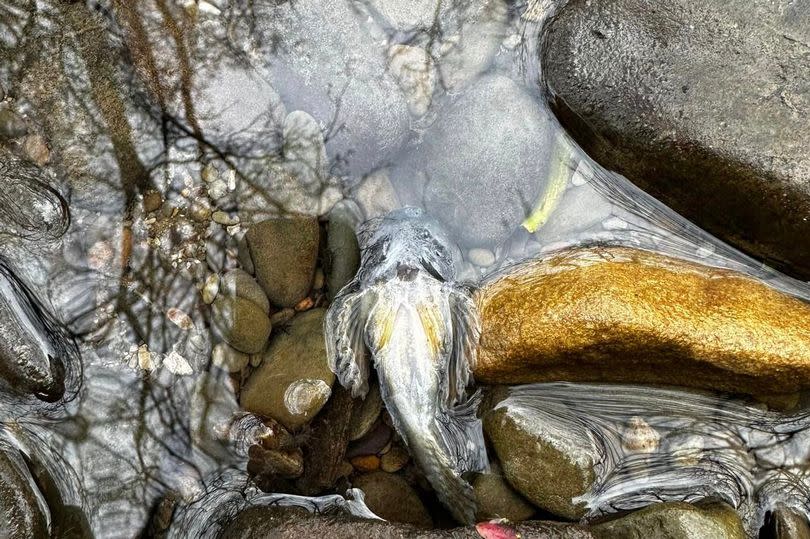'Significant concentration of formaldehyde' enters Welsh river

A leaked memo has sparked health and safety fears after revealing that a "significant concentration of formaldehyde" has entered a Welsh river. The internal document from Natural Resources Wales (NRW), which North Wales Live has seen, highlights serious concerns for staff tasked with work near the affected area.
The alert follows the discovery of numerous dead fish in the River Alyn, a consequence of a severe blaze at the Synthite chemical plant in Mold on Tuesday afternoon. NRW is currently probing both the fish fatalities and the broader environmental repercussions of the fire.
In response to the incident, NRW advised the public on Wednesday to steer clear of the river and to prevent animals from coming into contact with the water. Reports emerged yesterday of locals encountering deceased fish and other wildlife along the river, which feeds into the larger River Dee, supplying drinking water to almost three million individuals.
READ MORE: The most pointless job in Wales
READ MORE: The real fury behind the scenes in Welsh Labour as Vaughan Gething turns the party against him
The memo warns: "Please be aware there is a major pollution incident on the River Alyn and on the River Dee. There is a significant concentration of formaldehyde that has entered the River Alyn near Mold."
Synthite had previously assured in a statement on Wednesday that "no chemicals were released during or after the incident, with frequent air monitoring in place". They continued, stating: "As the incident was contained to site and no chemicals were released, there was no requirement to sound our siren.", reports North Wales Live, which sought comment from both NRW and Synthite regarding the situation.
Formaldehyde, a colourless chemical with a strong odour and flammability commonly found in construction materials like particleboard, plywood, and other pressed-wood items, is produced industrially by Synthite. This chemical poses a significant risk to aquatic life and can also be detrimental to humans depending on the exposure duration and quantities involved. Accordingly, the NRW has issued an advisory for its staff members to converse with an area manager prior to commencing any work in this region.
The warning further read: "There are significant health and safety concerns related to this incident and we want to ensure the safety of all our colleagues. The impacts from this incident are still being investigated so please check before working in this area."
Lyndsey Rawlinson, a representative from Natural Resources Wales, stated this week: "The multi-agency approach continues as we monitor and try to minimise the impact on the community and environment. Officers remain on site as part of the on-going operation."
She confirmed that approximately 50 dead fish have been discovered, further samples will be collected around the location and even further downstream for analysis. Actions needed to identify and mitigate any downstream impacts will be implemented.
To minimise possible harm she added: "As a precaution, we're asking people not to go near the River Alyn and to also keep animals away from the water. Multi agencies will continue to work together to minimise the impact on the community and environment."
Synthite has confirmed: "As North Wales Fire and Rescue Service operations now scale down, we are grateful to all emergency responders for their efforts. We again wish to thank local residents for their patience and sincerely apologise for any inconvenience caused. We are continuing to work closely with multiple agencies, including Natural Resources Wales, with this ongoing incident, and activity includes analysing samples of water from the River Alyn. Updates will be provided when further information is available."
Both North Wales Police and Fire and Rescue Service are supporting the Health and Safety Executive in their inquiry into the blaze.
Just because formaldehyde is present doesn't automatically mean there's a risk to health. For it to have negative effects, one must come in contact with it. Contact may occur through inhalation, consumption or skin exposure. The likelihood of experiencing adverse health effects after exposure to a chemical depends on numerous factors, including exposure level, method of exposure, exposure length, the state of the chemical and if there were any simultaneous exposures to other substances.
Breathing in formaldehyde can cause irritation of the respiratory tract, including the nose, mouth and throat. In extreme cases, difficulty breathing and inflammation of the larynx and lungs could develop. Swallowing formaldehyde can lead to burns and ulcers in the stomach or intestines shortly after ingestion. Symptoms may include chest or abdominal pain, nausea, vomiting, diarrhoea, and bleeding in the gastrointestinal tract. Other signs include rapid breathing, yellowish skin discolouration, blood in urine, and kidney failure.
When eyes are exposed to formaldehyde vapour or splashes, immediate irritation occurs, causing stinging, burning sensations, eyelid spasms, and tearing. Skin contact with formaldehyde can result in skin irritation and allergic contact dermatitis (an allergic reaction caused by direct contact with a substance, leading to skin redness or rashes). High concentrations of formaldehyde solutions can cause blisters and hives upon skin contact.
The International Agency for Research on Cancer (IARC) has classified formaldehyde as a carcinogenic substance in humans. Evidence suggests that formaldehyde can cause nasal tumours and leukaemia in industrial workers exposed over long periods (years). However, short-term exposure is unlikely to carry the same level of risk.
People with respiratory conditions like asthma may be more susceptible to the effects of formaldehyde. Those who are sensitised to formaldehyde may develop an allergic reaction (such as allergic contact dermatitis) upon exposure to the chemical.

 Yahoo News
Yahoo News 
